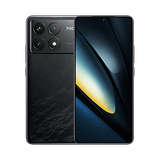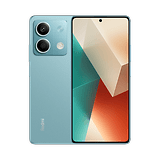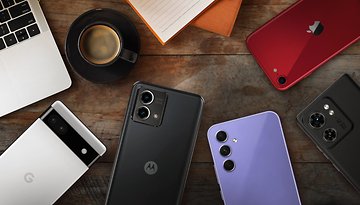Xiaomi or Samsung? Phones, Ecosystems and Updates Compared


Xiaomi or Samsung? If you're looking for an Android smartphone in 2024, you can't escape this question. To help you decide between the Galaxy S24 Ultra and the Xiaomi 14 Ultra, or between the Galaxy A55 and the Redmi Note 13 Pro+, we've compared the smartphone ranges of Xiaomi and Samsung.
At the top of the ranking of the biggest Android smartphone manufacturers are Xiaomi and Samsung. While Samsung has been leading the way for over ten years with its Galaxy smartphones, Xiaomi remains a relatively young company. Despite this, the Chinese electronics giant has managed to carve out a huge market share in Europe in recent years.
Both manufacturers use Android and cover a wide price range. That's why we're dividing this article into three price categories: high-end smartphones, mid-range smartphones, entry-level models and foldable smartphones. Also, we're going to tell you about the two respective ecosystems as well as Samsung and Xiaomi's overlays.
Xiaomi vs. Samsung: Smartphone Catalogs Compared
Flagship
Let's begin with a bang by looking at the models that determine the image of the brands in 2024: the flagships. Here, both Xiaomi and Samsung showcase new technologies on offer at mouthwatering prices. Here are the current models in comparison.
Xiaomi vs Samsung: Flagships
We saw the global launch of the Xiaomi 14 series at MWC 2024 and Samsung had already presented its Galaxy S24 series in January. Both manufacturers followed up in the second half of the year and completed the series with the two "T" models from Xiaomi and the "Fan Edition" from Samsung.
Since you can look at the exact differences in the table, we will concentrate on the clearest similarities and differences. Both smartphone series offer the latest technologies such as OLED displays with 120 Hertz, multiple cameras with high resolutions, and current wireless standards such as 5G, Bluetooth 5.3 / 5.4, and Wi-Fi 6E / 7. There is also the latest Android 14 with several years of updates.

However, there are still some differences to take note of. For example, Xiaomi is ahead in terms of quick charging and battery performance. In return, Samsung negotiated a deal with processor maker Qualcomm to supply overclocked versions of the Snapdragon chips, which debuted in the Xiaomi phones.
Samsung continues to outperform its rival when it comes to software updates. While Xiaomi now offers four years of Android updates and five years of security updates, Samsung is now ahead with seven important Android updates and seven years of security updates on its 2024 flagships.
As you can see: Xiaomi and Samsung hardly have anything to separate themselves in the flagship market. While there are minor differences between the lineups, both manufacturers represent the latest technologies in the smartphone world with their models.
Mid-range
If you still look at only the most expensive models when it comes to smartphones, you are missing out on a lot. This is because the mid-range market continues to be the most exciting one since 2021 until now. Both Xiaomi and Samsung have launched extremely popular mid-range devices over the past two years, and nearly all of them offer a good price-performance ratio.
| Xiaomi Redmi mid-range phones | Samsung Galaxy A mid-range phones | Xiaomi Poco mid-range | |||||||
|---|---|---|---|---|---|---|---|---|---|
| Product | |||||||||
| Picture |  |
 |
 |
 |
 |
 |
 |
 |
 |
| Review |
|
|
|
|
|
|
|
|
|
| Display |
|
|
|
|
|
|
|
|
|
| SoC |
|
|
|
|
|
|
|
|
|
| Memory |
|
|
|
|
|
|
|
|
|
| OS |
|
|
|
|
|
|
|
|
|
| Camera |
|
|
|
|
|
|
|
|
|
| Selfie Camera |
|
|
|
|
|
|
|
|
|
| Battery |
|
|
|
|
|
|
|
|
|
| Connectivity |
|
|
|
|
|
|
|
|
|
| IP Certification |
|
|
|
|
|
|
|
|
|
| Dimensions and weight |
|
|
|
|
|
|
|
|
|
| Offers* |
|
|
|
|
|
|
|
|
|
Despite all the attention in the flagship arena, the most heated battles probably happen in the mid-range space. With duels like the Redmi Note 12 Pro+ versus the Galaxy A54, the category includes some of the best-selling models from both brands.
Xiaomi is considered the manufacturer with the best price-performance ratio in the smartphone world, and that is to be taken quite literally in this case. Not only does the Chinese company offer superlative specifications on its Redmi Note 13 lineup, but it also counts on sub-brand Poco to offer flagship performing phones for mid-range prices.
In addition to its Redmi range, Xiaomi also offers mid-range smartphones under the Poco brand. These models are known for offering excellent performance with high-end SoCs and more daring designs.
However, Xiaomi's software update policy is slightly behind Samsung's despite recent improvements, and the pre-installed HyperOS operating system does contain plenty of bloatware and even ads that require you to deactivate in a rather awkward manner. Also, their availability in the US is almost zero, with only independently imported models available in marketplaces.

Samsung is clearly positioning itself as a brand for premium smartphones in the mid-range segment. The models presented in 2021 launched in 2021 already boasted one of the longest update guarantees on the smartphone market. Samsung is now continuing this with the Galaxy A35 and Galaxy A55, offering security patches for five years and Android updates for four years.
However, the phones do not have to hide in terms of specifications either. You get particularly high-quality AMOLED displays, triple or quad cameras with optical image stabilization, and sufficiently fast processors for the mid-range. However, Samsung cannot hold a candle to Xiaomi when it comes to fast charging times for smartphones, especially considering the Galaxy A models launched since 2022 do not come with a charger in the box.
Entry-level class
If smartphones are mainly supposed to be inexpensive, you have seen an exciting development in recent years. For a long time, Xiaomi was the first port of call for phones costing less than 200 euros. Samsung has responded to this and even launched entry-level smartphones such as the Samsung Galaxy A15 (review) onto the market. Ultimately, the same advantages and disadvantages apply as in the mid-range.
| Redmi | Poco entry-level phones | Samsung Galaxy A entry-level phones | ||||||
|---|---|---|---|---|---|---|---|
| Product | |||||||
| Picture |  |
 |
 |
 |
 |
 |
 |
| Review |
|
|
|
|
|
|
|
| Display |
|
|
|
|
|
|
|
| SoC |
|
|
|
|
|
|
|
| Memory |
|
|
|
|
|
|
|
| OS |
|
|
|
|
|
|
|
| Camera |
|
|
|
|
|
|
|
| Selfie Camera |
|
|
|
|
|
|
|
| Battery |
|
|
|
|
|
|
|
| Connectivity |
|
|
|
|
|
|
|
| IP Certification |
|
|
|
|
|
|
|
| Dimensions and weight |
|
|
|
|
|
|
|
| Offers* |
|
|
|
|
|
|
|
This means that Xiaomi normally offers a bit more performance and features for the same amount of money. Samsung, however, convinces with solid hardware, normally really good build quality, and its own Android skin, OneUI. However, we have to point out a special caveat for Xiaomi in this entry-level category.
Xiaomi also sells smartphones that have a particularly good price-performance ratio under the Poco brand. The manufacturer's plan here is to offer the best possible hardware at the lowest possible price. For a market overview, take a look at our list of the best smartphones you can buy today for under $200.
Foldable smartphones
Since 2018, a whole new smartphone category has opened up: foldable phones with touchscreens that simply fold in half. Although Xiaomi and Samsung introduced their first foldables pretty promptly, Samsung is clearly ahead of everyone else here. From 2021 until now, Samsung's foldable smartphones continue to be the clear buying recommendation for unique handsets.
| Samsung 2024 foldables | Xiaomi's challengers | Samsung 2023 foldables | ||||
|---|---|---|---|---|---|---|
| Product | ||||||
| Image |  |
 |
 |
 |
 |
 |
| Review |
|
|
|
|
|
|
| Display |
|
|
|
|
|
|
| Processor |
|
|
|
|
|
|
| Memory |
|
|
|
|
|
|
| OS |
|
|
|
|
|
|
| Camera |
|
|
|
|
|
|
| Selfie camera |
|
|
|
|
|
|
| Battery |
|
|
|
|
|
|
| Connectivity |
|
|
|
|
|
|
| IP certification |
|
|
|
|
|
|
| Dimensions and weight |
|
|
|
|
|
|
| Offers* |
|
|
|
|
|
|
However, you still have to expect a crease in the display and high prices. While the Samsung Galaxy Z Fold 6 (test) offers a format that turns a conventional smartphone into a tablet when unfolded, the Galaxy Z Flip 6 (test) is more reminiscent of a classic flip phone. You can turn half a cell phone into a cell phone in standard smartphone format.

Xiaomi presented the Mi Mix Fold in 2021 and has since moved on to the Mix Fold 4. The foldable follows a similar concept to the Samsung Galaxy Z Fold 6 but has not yet been officially released in the West. With the Xiaomi Mix Flip, the first Xiaomi foldable has now officially set foot on European soil, but with no hopes of ever reaching North America.
Software and data protection
You have already read a bit about it in the earlier paragraphs concerning both smartphone offerings: Samsung is better positioned than Xiaomi in terms of software updates. To provide you with a better idea of this, we will take a closer look at both operating systems once again.
Samsung's One UI
As the name suggests, Samsung's One UI is used on all Android devices from the manufacturer. The Samsung-optimized Android interface is considered a thing of beauty among skins and offers numerous additional features like extended multitasking features, support for Samsung's S Pen stylus, and native support for Samsung services like Samsung's S Cloud.

In our review of Samsung's latest One UI 6 skin, you can read about the myriad of options Samsung has implemented with the corresponding update to Android 14.
Apart from the features, you can look forward to the fact that, in addition to Samsung's own services, there is very little bloatware pre-installed and you sometimes get extremely long updates. A seven-year update promise was made for flagship phones—both for security updates and the major Android versions.
- Take a look at our selection of the best features and tips for Samsung smartphones with One UI 5 or 6.
However, not everything is perfect in Samsung's software either. The huge size of Samsung's operating systems tends to stand out in reviews. Thus, you have to live with having up to 15% of the available storage space used up even before you set up your Samsung smartphone.
Samsung also works increasingly on implementing its own hardware and software ecosystem. For instance, you can only use the multi-pairing feature of the Samsung Galaxy Buds Pro with other Samsung devices.
Artificial intelligence plays an important role in Samsung's software strategy. With its Galaxy AI, Samsung has also introduced the right platform with many amazing functions.
Xiaomi MIUI / HyperOS
The MIUI operating system emerged from a former custom ROM for rooted Android phones. Xiaomi adopted the operating system and has since developed it further. MIUI has now become HyperOS, meaning that this new interface, which has yet to emancipate itself from MIUI, can be found on newer models.

Xiaomi also considerably improved its OS update policies, especially for flagship phones, with five years of security updates, the same Samsung offers for its intermediate models. In the mid-range market, Xiaomi is now promising four years of security updates, which should be good enough for most people. On the other hand, Xiaomi repeatedly attracts negative attention with ads and bloatware on its phones.
For many people, Xiaomi's operating system is also questionable because it is not entirely transparent with how the collected data is handled. As a Chinese company, Xiaomi has to strongly comply with the country's data protection regulations. Thus, if you want to be sure that your data is not passed on to the Chinese Communist Party, you might want to look for another manufacturer. This is a political issue, but we do not want to enter this territory.
AI has also long played a major role at Xiaomi. With the Xiaomi 14T models, Xiaomi also announced new AI functions for Xiaomi phones. These include its own AI features, but Google tools such as Gemini and Circle to Search will also find their way onto the devices.
Wearables and other devices
Both Xiaomi and Samsung do not only see themselves as smartphone rivals. This is because, with the purchase of a new smartphone, you also gain a doorway into an ecosystem of other devices. Both manufacturers offer smartwatches, fitness trackers, tablets, TVs, in-ear Bluetooth headphones, and even washing machines or smart toilet seats. However, we only review wearables and tablets from these product categories.
Wearables and other devices tested
| Category | Samsung | Xiaomi |
|---|---|---|
| Smartwatches | Samsung Galaxy Watch 6 | Xiaomi Watch 2 Pro |
| Fitness tracker | Samsung Galaxy Fit 2 | Xiaomi Smart Band 8 |
| Tablets | Samsung Galaxy Tab S9 Ultra | Xiaomi Mi Pad 6 |
| Headphones | Samsung Galaxy Buds 2 Pro | Xiaomi Redmi Buds 4 Lite |
In the table above, you can find current reviews of these devices from Xiaomi and Samsung. However, we only want to highlight this segment to you in order to illustrate the ecosystems of both manufacturers. Overall, Xiaomi and Samsung do not give each other much elbow room in this respect. If you feel comfortable with devices from a certain manufacturer, you can sit back and continue shopping with both Samsung and Xiaomi.
Price stability and sustainability
Xiaomi is a prime example of a manufacturer that produces so-called "fast phones". In other words, smartphones are inexpensive to buy and reach the end of their life cycle after around two years. The manufacturer offers quick-charging technologies that shorten the battery lifespan and an update guarantee that corresponds to a similar time frame. Only the most expensive Xiaomi smartphones offer a longer update guarantee with three years of security updates.
The story is slightly different when it comes to Samsung. As mentioned earlier, numerous Samsung smartphones will now receive long-term support updates. The new devices from the S24 series, for example, can be safely used until 2031 like recent Pixel phones. The workmanship on these handsets is good enough that the devices should be able to last until then with a little bit of extra care and caution. However, even Samsung is not immune to the fast phone culture with its entry-level smartphones. The rule of thumb here is: The more expensive a Samsung smartphone is, the longer you can theoretically use it.

However, neither brand is a particularly sustainable smartphone manufacturer. Samsung omits the chargers in many of its more expensive smartphones and relies on plastic parts made from recycled fishing nets in the S22 series. Xiaomi did plan something similar with the Mi 11 but ultimately decided against leaving the charger out of the packaging for the Western market.
However, avoiding electronic waste by omitting the charger is not a prime example of sustainability at Samsung either. Small steps in the right direction should therefore not be a reason to buy Samsung in any case. If sustainability is important to you, you should go for models like the Shiftphone or Fairphone 5, which can be repaired and upgraded due to their modular form factor.
Conclusion
Xiaomi or Samsung—which smartphone manufacturer offers more in the end? This question is probably harder to answer for any other pair of brands than for the competitors from China and South Korea. After all, both manufacturers offer models for beginners all the way to the high-end market or niche markets such as foldables.
However, Samsung still positions itself more toward being a manufacturer of premium smartphones in 2024, which is justified by models like the expensive Galaxy S24 Ultra and the latest foldables. Even with its own Ultra flagship, Xiaomi still carries the reputation of being a highly recommended bang-for-the-buck smartphone manufacturer with fantastic mid-range offerings, as these are the strengths of the company by stretching your hard-earned dollar.
Samsung's big ace up its sleeve, however, is One UI—and a particularly long update warranty. This will allow Samsung to further strengthen its image as a premium brand this year. Xiaomi is still trying to narrow this gap.
We can expect the Xiaomi 15 series to be unveiled in China very soon—by then at the latest, you should take another look at our article here and check what has happened at Xiaomi. Either way, the duel between the two cell phone giants remains exciting—and nothing will change in 2025!
The article was updated in October 2024 with additional models.


















I think looking at them as ecosystems is a dreadful mistake. The best thing you can do as a user to protect your privacy and surround yourself with the best apps is to use disable and uninstall as many of built-in apps and services. And then install ones that work the way you want them to that protect your privacy and rights.
Neither of these brands is consumer friendly, rather consumer hostile. They try to pull as much data as they can and feed you ads. You are a data and income stream and paying for the privilege.